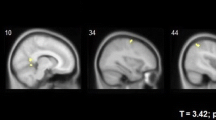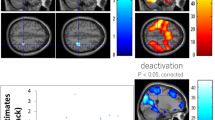Abstract
Gyrification of the cortical mantle is a dynamic process that increases with cortical surface area and decreases with age. Increased gyrification is associated with higher scores on cognitive tasks in adults; however, the degree to which this relationship is independent of cortical surface area remains undefined. This study investigates whether regional variation in gyrification is associated with domain-general and domain-specific cognition. Our hypothesis is that increased local gyrification confers a functional advantage that is independent of surface area. To quantify regional gyrification, we computed the local gyrification index (LGI) at each vertex and averaged across a bilateral parietal-frontal region associated with general intelligence and reasoning (Jung and Haier 2007). A sample of 48 healthy adults (24 males/24 females; ages 18–68 years) completed a high-resolution 3 T T1-weighted MRI and standardized administration of the Wechsler Adult Intelligence Scale (WAIS). We found a positive correlation between cortical gyrification and working memory, which remained significant after controlling for cortical surface area. Results suggest that a higher degree of local cortical folding confers a functional advantage that is independent from surface area and evident for more dynamic or “fluid” cognitive processes (i.e., working memory) rather than over-learned or “crystallized” cognitive processes.


Similar content being viewed by others
References
Allman, J. M. (1999). Evolving brains (pp. 116–156). New York: Freeman WH.
Buzsáki, G. (2006). Rhythms of the brain (pp. 36–7). New York: Oxford UP.
Buzsáki, G., Geisler, C., Henze, D. A., & Wang, X. J. (2004). Interneuron diversity series: Circuit complexity and axon wiring economy of cortical interneurons. Trends in Neuroscience, 27, 186–193.
Cattell, R. B. (1963). Theory of fluid and crystallized intelligence: A critical experiment. Journal of Educational Psychology, 54(1), 1.
Dale, A. M., Fischl, B., & Sereno, M. I. (1999). Cortical surface-based analysis. I. Segmentation and surface reconstruction. Neuroimage, 9, 179–194.
Dobbing, J., & Sands, J. (1979). Comparative aspects of the brain growth spurt. Early Human Development, 311, 79–83.
Docherty, A. R., Hagler Jr., D. J., Panizzon, M. S., Neale, M. C., Eyler, L. T., Fennema-Notestine, C., et al. (2015). Does degree of gyrification underlie the phenotypic and genetic associations between cortical surface area and cognitive ability? NeuroImage, 106, 154–160.
Douglas, R. J., & Martin, K. A. C. (2004). Neuronal circuits of the neocortex. Annual Review of Neuroscience, 27, 419–451.
Finn, E. S., Shen, X., Scheinost, D., Rosenberg, M. D., Huang, J., Chun, M. M., Papademetris, X., & Constable, R. T. (2015). Functional connectome fingerprinting: Identifying individuals using patterns of brain connectivity. Nature Neuroscience, 18, 1664–1671.
Fischl, B., & Dale, A. M. (2000). Measuring the thickness of the human cerebral cortex from magnetic resonance images. Proceedings of the National Academy of Sciences, 97, 11050–11055.
Fischl, B., van der Kouwe, A., Destrieux, C., Halgren, E., Ségonne, F., Salat, D. H., et al. (2004). Automatically parcellating the human cerebral cortex. Cerebral Cortex, 14, 11–22.
Gautam, P., Anstey, K. J., Wen, W., Sachdev, S. P., & Cherbuin, N. (2015). Cortical gyrification and its relationships with cortical volume, cortical thickness, and cognitive performance in healthy mid-life adults. Behavioral Brain Research, 287, 331–339.
Herculano-Houzel, S., Mota, B., & Lent, R. (2006). Cellular scaling rules for rodent brains. Proceedings of the National Academy of Sciences, 03(32), 12138–12143.
Herculano-Houzel, S., Collins, C. E., Wong, P., & Kaas, J. H. (2007). Cellular scaling rules for primate brains. Proceedings of the National Academy of Sciences, 104(9), 3562–3567.
Hof, P. R., Chanis, R., & Marino, L. (2005). Cortical complexity in cetacean brains. The anatomical record. Part A, Discoveries in molecular, cellular, and evolutionary biology, 287, 1142–1152.
Jung, R. H., & Haier, R. J. (2007). The parieto-frontal integration theory (P-FIT) of intelligence: Converging neuroimaging evidence. Behavioral Brain Science, 30, 135–154.
Kaas, J. H. (2009). Cerebral Fissure Patterns (pp. 739–800). Oxford: Elsevier.
Larkum, M. E., Senn, W., & Lüscher, H.-R. (2004). Top-down dendritic input increases the gain of layer 5 pyramidal neurons. Cereral. Cortex, 14, 1059–1070.
Li, G., Wang, L., Shi, F., Lyall, A. E., Lin, W., Gilmore, J. H., & Shen, D. (2014). Mapping longitudinal development of local cortical gyrification in infants from birth to 2 years of age. Journal of Neuroscience, 34(12), 4228–4238.
Luders, E., Narr, K. L., Bilder, R. M., Szeszko, P. R., Gurbani, M. N., Hamilton, L., et al. (2008). Mapping the relationship between cortical convolution and intelligence: Effects of gender. Cerebral Cortex, 18, 2019–2026.
Moore, M. J., Knowlton, A. R., Kraus, S., McLellan, W. A., & Bonde, R. K. (2004). Morphometry, gross morphology, and available histopathology in North Atlantic right whale (Eubalaena glacialis) mortalities. Journal of Cetacean Research and Management, 6, 199–214.
Oldfield, R. C. (1971). The assessment and analysis of handedness: The Edinburgh inventory. Neuropsychologia, 1, 97–113.
Pillay, P., & Manger, P. R. (2007). Order-specific quantitative patterns of cortical gyrification. European Journal of Neuroscience, 25, 2705–2712.
Pucak, M., Levitt, J., Lund, J., & Lewis, D. (1996). Patterns of intrinsic and associational circuitry in monkey prefrontal cortex. Journal of Comparative Neruology, 376, 614–630.
Ronan, L., & Fletcher, P. C. (2015). From genes to folds: A review of cortical gyrificaiton theory. Brain Structure and Function, 220(5), 2475–2483.
Rubio-Garrido, P., Pérez-De-Manzo, F., Porrero, C., Galazo, M. J., & Clascá, F. (2009). Thalamic input to distal apical dendrites in neocortical layer 1 is massive and highly convergent. Cerebral Cortex, 19, 2380–2395.
Schaer, M., Caudra, M. B., Tamarit, L., Lazeyras, F., Eliez, S., & Thiran, J.-P. (2008). A surface-based approach to quantify local cortical gyrification. IEEE Transactions on Medical Imaging, 27, 161–170.
Schaftenaar, W., & Hildebrandt, T. (2006). Veterinary guidelines for reproduction-related management in captive female elephants. Elephant TAG Veterinary Advisors.
Striedter, G. F., Srinivasan, S., & Monuki, E. S. (2015). Cortical folding: When, where, how and why? Annual Review of Neuroscience, 38, 291–307.
Van Essen, D. C. (1997). A tension-based theory of morphogenesis and compact wiring in the central nervous system. Nature, 385, 313–318.
Watts, D. J., & Strogatz, S. H. (1998). Collective dynamics of 'small-world' networks. Nature, 393, 440–442.
Wechsler, D. (1997). Wechsler Adult Intelligence Scale – third edition. San Antonio: Pearson.
Wechsler, D. (2008). Wechsler Adult Intelligence Scale – fourth edition. San Antonio: Pearson.
Welker, W. (1990). Why does the cerebral cortex fissure and fold? Cerebral Cortex, 8, 3–136.
Zilles, K., Armstrong, E., Schleicher, A., & Kretschmann, H. J. (1988). The human pattern of gyrification in the cerebral cortex. Anatomy and Embryology (Berlin), 179, 173–179.
Author information
Authors and Affiliations
Corresponding author
Ethics declarations
Funding
The study was funded by generous support from Finding a Cure for Epilepsy and Seizures (FACES).
Conflict of interest
Sophie Green declares that she has no conflict of interest. Orrin Devinsky declares that he has no conflict of interest. Karen Blackmon declares that she has no conflict of interest. Jonathan DuBois declares that he has no conflict of interest. Xiuyuan Wang declares that he has no conflict of interest. Eric Halgren declares that he has no conflict of interest. Thomas Thesen declares that he has no conflict of interest.
Ethical approval
All procedures performed in studies involving human participants were in accordance with the ethical standards of the institutional and/or national research committee and with the 1964 Helsinki declaration and its later amendments or comparable ethical standards.
Informed consent
Informed consent was obtained from all individual participants included in the study.
Rights and permissions
About this article
Cite this article
Green, S., Blackmon, K., Thesen, T. et al. Parieto-frontal gyrification and working memory in healthy adults. Brain Imaging and Behavior 12, 303–308 (2018). https://doi.org/10.1007/s11682-017-9696-9
Published:
Issue Date:
DOI: https://doi.org/10.1007/s11682-017-9696-9




